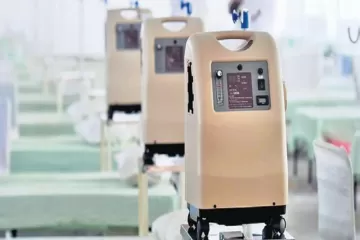Types of oxygen concentrator

In this blog, we will look at the types of oxygen concentrators. Before that, you must know what an oxygen concentrator is. Let's look at what an oxygen concentrator is and who requires it.
What is an oxygen concentrator?
Nitrogen makes up 78% of the atmosphere, whereas oxygen makes up 21%. An oxygen concentrator compresses atmospheric oxygen by removing nitrogen from it and providing it to a person with a respiratory illness who is unable to breathe pure oxygen directly.
A patient can select between a stationary and portable oxygen concentrator depending on their preferred lifestyle and the flow rate suggested by their physician.
Let's take a look at some of the medical disorders that require oxygen therapy.
As you are probably aware, the sort of oxygen concentrator you need to purchase is mostly determined by the severity of your medical condition. Supplemental oxygen is usually required by people with the following medical conditions: COPD, Asthma, Pneumonia, Bronchopulmonary dysplasia (underdeveloped lungs in newborn children), Sleep Apnea, etc.
There are two types of oxygen concentrators.
Home/Stationary Oxygen Concentrators
Home oxygen concentrators, as one of the most dependable sources of oxygen therapy, can meet the needs of all sorts of hypoxic patients since their strong compressors can combine high flow with high output pressure.
There are several options available:
Medium Flow (5 Litres Per Minute), High Flow, and Low Flow. If you're prescribed oxygen at a flow rate less than 5 LPM and are confident that your oxygen needs won't change in the future, a 5 LPM oxygen concentrator is a good choice.
High Flow (10 LPM) home oxygen concentrator:
Patients with chronic COPD, ILD, and other respiratory illnesses are given oxygen therapy with a flow rate of greater than 6 LPM. Home oxygen concentrators with a flow rate of 10 LPM can meet all of your demands in these situations.
In addition, it has been discovered that the oxygen requirement of ILD patients grows dramatically over time. For such patients, having a high-flow oxygen concentrator on hand will be beneficial.
Now let us look at the second type of oxygen concentrator i.e, the portable oxygen concentrator.
Portable Oxygen Concentrators
Patients can take this concentrator with them everywhere they go because they are meant to be portable. If you have a medical condition that requires you to rely on supplemental oxygen for an extended period of time, a portable oxygen concentrator will allow you to go about your daily activities without difficulty.
Portable oxygen concentrators typically give oxygen up to six pulse settings, which is comparable to a flow rate of six liters per minute. If your requirements are less than this, you can certainly use it. Now let’s look at its type.
Pulse dose
These oxygen concentrators monitor the patient's breathing patterns and only give oxygen when the patient inhales. This ingenious and creative solution preserves the device's battery, which would have been wasted if it provided oxygen during exhale as well.
The majority of portable oxygen concentrators work in pulse mode. However, people with sleep apnea or who breathe through their mouth may not find this equipment useful because it may not be able to detect their breath.
Pulse and Continuous dose
Only a few companies, such as Philips and SeQuel, make portable oxygen concentrators that can administer oxygen in both pulse and continuous flow modes.
When the machine is set to continuous flow mode, oxygen is dispensed both during inhalation and exhalation. This eliminates the disadvantage of pulse flow mode. You may easily switch between the two modes depending on your preferences.
When set to continuous mode, portable oxygen concentrators may deliver up to 2 or 3 LPM of oxygen. This may not meet the demands of the majority of patients. In such cases, you may need to invest in a home oxygen concentrator.
However, if you need high-flow oxygen, most portable oxygen concentrators won't be enough. In such instances, a 10 LPM home oxygen concentrator will be enough for the bulk of the day, and you may switch to a portable one if you wish to go out for a few hours.
Adjustable Purity Oxygen Concentrators
Adjustable Purity Oxygen Concentrators seen in the recent spike in Covid-19 instances, these oxygen concentrators have become popular, however, they are not advised for medical use.
When we increase the flow rate of these types of oxygen concentrators, the oxygen purity level lowers dramatically. The oxygen purity may drop to as low as 30% as the flow rate is increased to its maximum level. Patients with respiratory diseases require supplemental oxygen with at least a 90% oxygen purity rate, which this does not provide.
If you have a persistent breathing problem, you should avoid purchasing this gadget since, while it may be inexpensive, it is not suited for medical use.
